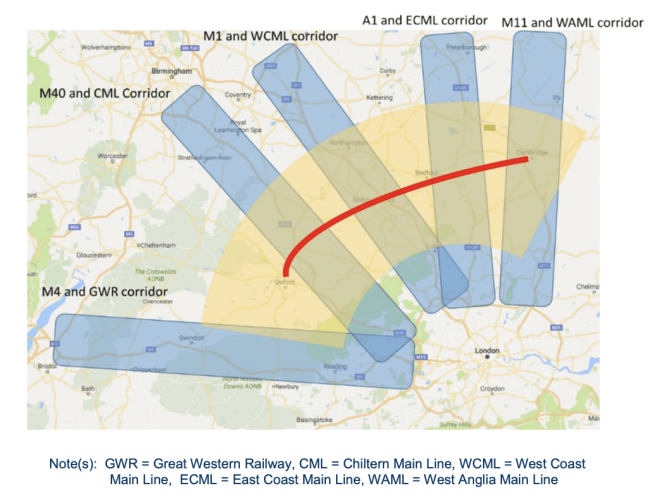R&D Across Oxford-Cambridge Arc Offers Hope In An Age of Uncertainty

Categories :
R&D Collaboration Across Oxford-Cambridge London Arc Offers Hope In An Age of Uncertainty
News release
While economists sought to rejig their models following the financial crisis, adjusting for a pandemic, the likelihood of a cure and a whole range of science and tech related variables in between presents a far greater challenge.
Delving into how the Oxford-Cambridge Arc is performing during the current climate, Sue Foxley, Research Director at Bidwells shares insight into how R&D collaboration in the arc offers hope after the crisis is over.
As scientists and medical professionals take principal role in the news, the interconnectedness of R&D is becoming clear. Open innovation in research has in recent years encouraged organisations, whether public or private to work symbiotically, with others. This has driven joint innovations between internationally renowned teaching hospitals or pharmaceuticals giants and start-ups often coming out of universities. Examples of this collaborative model are evident across today’s science and technology sectors.
No more so than across the Golden Triangle where London connects with the Oxford – Cambridge Arc. The Arc stretches across 2.8m acres, comprising just 5% of the UK landmass, but is home to 22% of the nation’s science park floorspace. Across the region researchers and high-tech manufacturers have taken leading roles in the UK’s COVID-19 response, including a presence in key initiatives including the government’s Vaccine Taskforce and the private sector led Ventilator Challenge UK.
Three COVID-19 Oxford University based projects were among the first to benefit from a share of £20 million in government investment to fund trials and develop manufacturing processes to produce a vaccine at a million-dose scale. The team at the Jenner Institute is starting clinical testing shortly. A further project will examine how existing treatments could be repurposed to treat coronavirus.
Cambridge is home to 9.1m sq ft of public and private sector science and business park floor space, with 51% of the commercial space occupied by life science activity. COVID-19 initiatives are already established across the market. These include a new testing laboratory is being established by AstraZeneca, GSK and Cambridge at the University’s Anne McLaren Building. This facility will be used for high throughput screening for COVID-19 testing and to explore the use of alternative chemical reagents for test kits in order to help overcome current supply shortages.
Meanwhile, the University of Cambridge Department of Engineering have adapted modelling tools originally designed to improve the efficiency of factories to manage the flow of patients at Addenbrooke’s Hospital. Elsewhere at the University researchers in the department of Computer Science and Technology have developed a new app, which will be used to collect data to develop machine learning algorithms that could automatically detect whether a person is suffering from COVID-19 based on the sound of their voice, their breathing and coughing.
In Milton Keynes, the National Biosample Centre, which was opened in 2015 and is the largest facility in the UK for storing and processing biological samples, has been converted into the UK’s biggest COVID-19 testing centre. Meanwhile, underlining the collaborative approach to R&D Mologic Ltd, located at Bedford Technology Park, is also working on a COVID-19 point-of-need diagnostic tests with the Liverpool School of Tropical Medicine and St George’s, University of London. Mologic was awarded circa £1 million as part of the UK government’s £46 million international coronavirus (COVID-19) prevention and research funding package.
The VentilatorChallenge UK consortium which comprises Siemens, Airbus, Ford, a number of Formula 1 teams, many of which are located in or around Silverstone Park, and other high tech engineering businesses across the Arc, have received approval from the Medicines and Healthcare products Regulatory Agency to start production of their Penlon Prima ES02 ventilator. The consortium aims to manufacture around 1,500 units a week. The consortium also plans to increase production of another existing design, the Smiths Group paraPAC, which is used for less acute patients.
Further joint initiatives are underway to the east of the Arc. Researchers at the University of East Anglia are working with the Queen Elizabeth Hospital in King’s Lynn and the Norfolk and Norwich Hospital to trial a portable coronavirus kit which could be rolled out to test NHS staff in weeks. The trial is led by researchers in Oxford.
The role of the Arc will not be limited to the current immediate challenge, but also the long-term struggles presented by the disease and the UK’s ability to pre-empt future events. The value of the Arc’s cluster is underlined by post-lockdown letting of 35,000 sq ft at Cambridge Science Park to Amegen, the largest occupational transaction in Cambridge in the first quarter. The biotech company has developed a strategic partnership with Adaptive Biotechnologies in the combine expertise US to potentially prevent or treat COVID.
The Chief Medical Officer Professor Chris Whitty recently stated, 'The world faces an unprecedented challenge in our efforts to tackle the spread of COVID-19 and it is vital we harness our research capabilities to the fullest extent to limit the outbreak and protect life.” The UK science and technology sectors have risen to this challenge.
The embedded culture of collaboration and innovation in the science and technology sector has been fundamental to the advances made. The evidence across the Oxford – Cambridge Arc ranging from diagnostic testing, manufacturing processes and potential vaccines, illustrate the power of the cluster.








